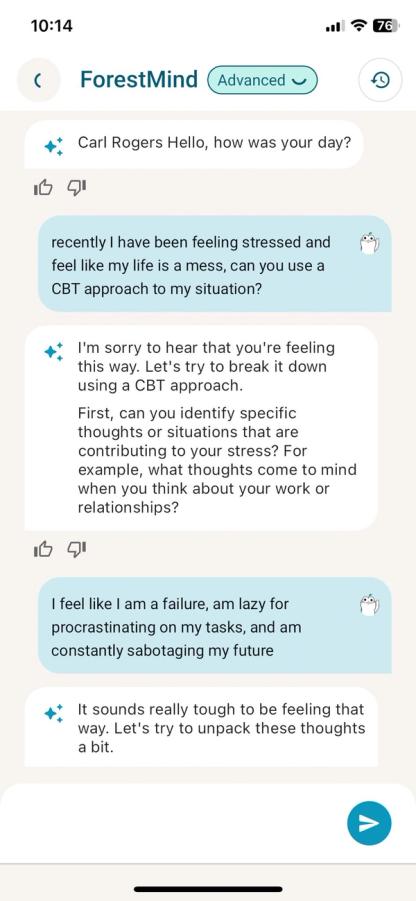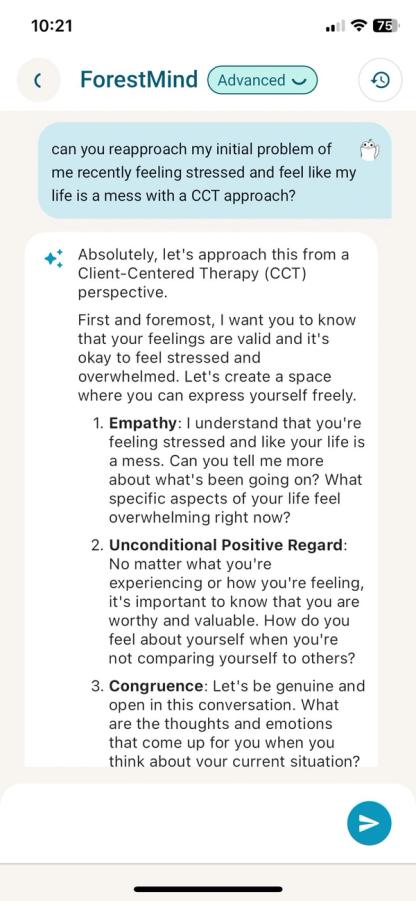
Ghosting and Avoidant Behaviour: Why We Pull Away and 3 Ways to Heal from It
Have you ever experienced ghosting? The two of you were chatting happily the night before, and the next day the person suddenly disappears, never replying again?
Client-centred therapy (CCT), pioneered by Carl R. Rogers, is a form of psychotherapy. As its name suggests, it is a therapy approach that prioritises active listening, understanding, empathy, respect and trust in the client’s innate self-awareness and self-control (Silani et al., 2013), fostering a connection and deep understanding with the client.

In today's rapidly evolving world, Artificial Intelligence (AI) has been gaining momentum in various industries worldwide, from manufacturing, and customer service to art creation.
While AI has proven to be efficient and effective in fulfilling any of its given tasks, the use of AI in the mental health field has been an ongoing debate. The question remains: can AI replace the intimacy and social presence of a human therapist or compete head-to-head with traditional therapeutic approaches like cognitive behavioural therapy (CBT)?
After having the chance to be a part of the journey of a developing AI psychotherapy app, mindforest.ai. As someone already familiar with various self-care apps, I initially expected more of the same, a digital companion offering generic support. What comes to my surprise is that it incorporates AI as a main feature, making self-growth accessible to the public for the day-to-day challenges we all face. This experience has opened my eyes to the potential of AI in transforming psychotherapy.
With AI’s language model being speedily advanced, gaining the ability to empathise with clients, along with its well-versed knowledge in psychology. AI could be proved to serve as an asset to modern psychotherapy, shedding new light on the role of AI as a tool to be of service to the public.
Take the most clinically researched therapy, cognitive behavioural therapy, as an example, clients often perceive a power imbalance between the therapist and themselves, with the therapist holding authority a majority of the time over sessions.
Speaking from my first experience with counselling, while engaging with the counsellor, the topic of religion is being discussed. At that time as an agnostic teenager in the process of exploring and questioning religion, it certainly was unpleasant to be labelled as a “soon-to-be Christian” without any prior mention of my faith. This experience has since then impacted my future counselling sessions, and made me refrain from openly discussing my thoughts on any topics related to religion. Now this is a case of power imbalance.
Notably, the factor of power imbalance exists beyond the topic of religion, according to Fors (2021), this includes:
Such power imbalance may be a consequential factor leading to the failure of establishing a therapeutic alliance, resulting in drop-outs (Sharf et al., 2010) and potentially hindering the client’s progress. In an environment where the client feels emotionally vulnerable and helpless. Eventually, who is to say if the clients will ever seek help again given the bad experience they have had? Are therapists the only “experts” and are they ultimately the only ones holding the power to make judgements? What if we reframe the power dynamic to be more client-focused instead?
Client-centred therapy (CCT), pioneered by Carl R. Rogers, is a form of psychotherapy. As its name suggests, it is a therapy approach that prioritises active listening, understanding, empathy, respect and trust in the client’s innate self-awareness and self-control (Silani et al., 2013), fostering a connection and deep understanding with the client. It also relies on the client’s active participation in the sessions, operating on the humanistic belief that the client possesses the capacity for growth and self-actualisation (Rogers, 1946). In other words, CCT allows the clients to be their own “experts”. By allowing the clients to partake in an active role in the sessions and essentially being their own “experts”, CCT leaves room for them to recognise their own emotions and behaviours, thus enabling them to gain more self-confidence for their journey of self-improvement.
However, CCT is not without its flaws. Although CCT aims to create an environment that fully values clients’ feelings and thoughts, it can still be challenging to adapt to clients’ needs case-by-case fully. Power imbalance could still arise especially when it is in a therapeutic setting involving two individuals from different cultural and social backgrounds with varying values (Kensit, 2000).
Large language models, like human therapists, come with their own value orientations (Rozado, 2024) which can subtly influence therapy. Clients may experience self-doubt or hesitation when sharing openly because they often feel vulnerable in comparison to the therapist. Moreover, even if the therapist is non-judgmental within the session, clients may still be affected by knowing that the therapist might hold different beliefs or ideologies outside the therapeutic setting through the therapist’s involuntary disclosure. When left unaddressed, this can hinder the therapeutic alliance and the client's openness.
To tackle challenges as such, AI offers a critical difference that human therapists cannot imitate, potentially overcoming this barrier. When we think of AI as a tool rather than as a person, the dynamic changes, from learning from a professional to learning to use our own tool. Just as we wouldn't blame a can opener when we struggle to open a can, but rather learn how to use it effectively, AI encourages a sense of autonomy and fosters a proactive approach to self-growth. This approach can empower clients to take ownership of their therapeutic journey without the complexities that human therapists might unintentionally introduce.
Modern AI offers a personalised and adaptable approach that caters to each client’s needs and eliminates the financial, time and location barriers of traditional in-person therapy. However, do clients hold a different attitude towards AI compared to human therapists?
Research by Lee et al. (2024) suggests that clients’ desires remain the same regardless, though their preference factors for AI counsellors differ depending on individual tendencies. With AI, the ability to tailor the ethics, gender and approach variables, which person-to-person therapies cannot achieve, ensures consistency and quality of the client-therapist alliance, allowing the client to get the most out of the use of AI. This degree of flexibility could be proven revolutionary for adopting the CCT approach while using AI as a supporting tool, changing the mental healthcare system fundamentally.
Most importantly, due to AI being an interactive-based tool, it primarily relies on the user’s instructions which directly affects its output. Clear instructions are crucial, compelling its users to think thoroughly about their goals and how to communicate their message effectively. As a result, utilising this characteristic of AI, as a passive tool that requires prompts to achieve its potential fully, it in turn encourages the clients’ active engagement with the AI, constantly reflecting their needs and desires.
Using Mindforest.ai as an example, when I tried to address my problems with a CBT approach, I felt like the emphasis was laid too heavily on my behaviours, which didn’t align with my personal preference. Therefore, I decided to switch to a CCT approach, which focuses more on my emotions. The ability to gain the autonomy to switch therapeutic approaches made me feel more comfortable opening up, as it did not make me feel like a problem that needed to be fixed but rather encouraged understanding and acceptance of my experience.


Consequently, AI psychotherapy acts as a facilitator in the client-centred approach, promoting self-awareness and empowerment through its interactive nature. Using AI as a tool allows clients to retain their autonomy in a therapeutic setting, taking ownership of their mental health and having the opportunity to learn to be more in touch with their emotions and needs, fostering an environment where clients can engage in self-regulated active learning. Therefore, cultivating self-reflection, self-awareness and insight.
The integration of AI and CCT marks a significant milestone in the psychotherapy field. Through bringing together the guiding and empathetic qualities of human therapists with the flexibility and adaptability of AI, now more than ever individuals can access tailored support that aligns with their unique needs and preferences, at your fingertips. Regardless of your gender, location, or financial status, with access to the internet, AI is available for everyone to use without any judgment or restriction. Moreover, practising self-reflection when using AI as a psychotherapy tool, creates an opportunity for personal growth through recognising and conceptualising your own emotions and then putting them into words. Ultimately, making AI a valuable tool for both self-help and personal growth.
As the demand for mental health care is rapidly growing, embracing the potential of the collaboration of AI and CCT holds a promising future for the betterment of the therapeutic experience and empowering individuals on their journey towards self-care, while encouraging growth and active learning. By exploring this innovative approach, we can pave the way for a more inclusive, accessible, and effective mental healthcare path that balances the strengths of both human empathy and technological advancement, thus, providing more options for the general public when accessing mental health facilities.
References
Conner, M. G. (2009). Transference, are you a biological time machine? Bendpsychology. http://www.bendpsychology.com/Articles/Transference.htm
Fors, M. (2021). Power Dynamics in the Clinical Situation: A Confluence of Perspectives. Contemporary Psychoanalysis, 57(2), 242–269. https://doi.org/10.1080/00107530.2021.1935191
Kensit, D. A. (2000). Rogerian theory: A critique of the effectiveness of pure client-centred therapy. Counselling Psychology Quarterly, 13(4), 345–351. https://doi.org/10.1080/713658499
Lee, J., You, J. S., & Lee, D. (2024). User Preferences on AI Psychotherapy Based on Moderating Effects of Individual Personality Traits: Employing a Clustering Analysis. International Journal of Human-Computer Interaction, 1–18. https://doi.org/10.1080/10447318.2024.2307695
Rogers, C. (1946). Significant aspects of client-centered therapy. American Psychologist, 1(10), 415–422. https://doi.org/10.1037/h0060866
Rozado, D. (2024). The political preferences of LLMs. PLoS ONE, 19(7), e0306621–e0306621. https://doi.org/10.1371/journal.pone.0306621
Sharf, J., Primavera, L. H., & Diener, M. J. (2010). Dropout and therapeutic alliance: A meta-analysis of adult individual psychotherapy. Psychotherapy: Theory, Research, Practice, Training, 47(4), 637–645. https://doi.org/10.1037/a0021175
Silani, G., Zucconi, A., & Lamm, C. (2013). Carl Rogers Meets the Neurosciences: Insights from Social Neuroscience for Client-Centered Therapy. Interdisciplinary Handbook of the Person-Centered Approach, 63–78. https://doi.org/10.1007/978-1-4614-7141-7_5
Smirthwaite, G., Lundström, M., Albrecht, S., & Swahnberg, K. (2013). Indication criteria for cataract extraction and gender differences in waiting time. Acta Ophthalmologica, 92(5), 432–438. https://doi.org/10.1111/aos.12230
van Doorslaer, E. (2006). Inequalities in access to medical care by income in developed countries. Canadian Medical Association Journal, 174(2), 177–183. https://doi.org/10.1503/cmaj.050584
Discover practical psychology tips you can apply to your everyday life. From building resilience to improving relationships and finding work-life balance, our blog brings expert-backed insights that help you grow.

Have you ever experienced ghosting? The two of you were chatting happily the night before, and the next day the person suddenly disappears, never replying again?

This article breaks down the psychology of nonchalance, signs of a nonchalant dater, the debate nonchalant vs chalant, and what truly matters when forming modern relationships.

Have you ever felt so intensely drawn to someone that you couldn’t stop thinking about them—imagining every possible interaction, decoding every message, overanalysing every glance? If so, you may not be experiencing love, but something more specific: limerence.
Download MindForest and turn these insights into action. Get personalized support from ForestMind AI Coach, track your progress, and unlock your full potential.